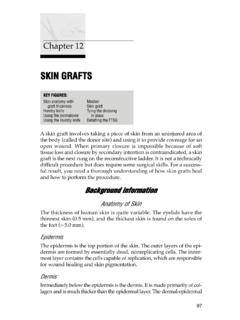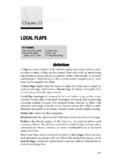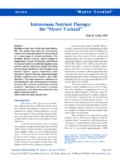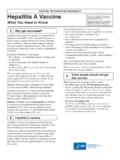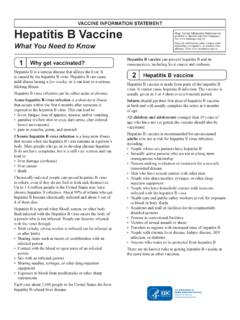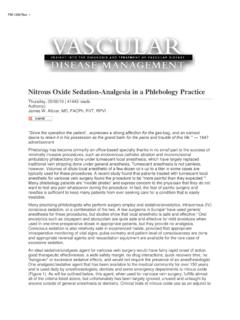Transcription of LOCAL ANESTHESIA - Practical Plastic Surgery
1 LLOOCCAALL AANNEESSTTHHEESSIIAAFull surgical evaluation of a wound and suture placement can bequite painful. You must anesthetize the injured area to perform theseprocedures properly. The administration of a LOCAL anesthetic allowsyou to evaluate and treat wounds in the emergency department orclinic. If you are unable to attain adequate pain control, the patientshould be taken to the operating room for exploration under anesthetics work by reversibly blocking nerve conduction. Theyprimarily block the sensation of sharp pain; they do not block pressuresensation. Therefore, in an area that has been adequately anesthetized,the patient will not feel the sharp needle stick during suture placementbut may feel a vague sensation of pressure.
2 This information should beshared with the patient. The duration of effect depends on how long the agent stays in the im-mediate working area before being absorbed into the circulation orbroken down by the surrounding AAggeennttss Topical agents (agents applied on top of the surrounding skin and ab-sorbed into the area to provide ANESTHESIA without injections) are nowavailable. However, they are quite expensive and can be used only onthe surface, not deep within an open wound. They can be quite effec-tive for performing simple excisions or starting intravenous topical agents may become important in the future, becauseof their expense and limited usefulness, they are not discussed furtherin this 3 KKEEYY FFIIGGUURREESS::Digital block/anatomyUlnar nerve infiltrationSensation to handFacial block: Median nerve infiltrationskeleton30 Practical Plastic Surgery for NonsurgeonsApplication of cold works for only a few minutes but may allowenough time to place one or two stitches.
3 Cold also may help by de-creasing the pain of LOCAL anesthetic injection . It can be especially usefulin children. Have the patient hold ice over the area for 5 minutes beforeinjection. Another way to apply cold is to spray the area with ethylchloride LLooccaall AAnneesstthheettiiccssThe easiest and most reliable way to anesthetize a wound is to inject alocal anesthetic. There are two techniques: (1) direct injection of thelocal anesthetic agent into the area around the wound and (2) injectionof the anesthetic agent around a sensory nerve that supplies sensationto the injured area. Both methods are addressed below, but first the twomost commonly used anesthetic agents are discussed.
4 Neither needs tobe refrigerated, which is important in the rural (Lignocaine)Lidocaine is the most commonly used and least expensive agent. Theusual total dose that can safely be given is 3 5 mg/kg body weight. Donot give more than this amount at one time. The ANESTHESIA becomes effec-tive after 5 10 minutes and lasts, on average, from 45 minutes to 1 (Marcaine)Bupivacaine is a longer-acting agent than lidocaine, but it is also moreexpensive. The usual total dose that can safely be administered at onetime is mg/kg. Bupivacaine takes a few minutes longer tobecome effective than lidocaine (10 15 vs. 5 10 minutes), but its effectcan last 2 4 hours. The longer duration of effect can be valuable.
5 Some wounds take morethan 1 hour to clean and suture. In addition, bupivacaine gives resid-ual pain control after the procedure is completed. Hand injuries are es-pecially prone to pain, making bupivacaine a good choice for treatinghand and finger both lidocaine and bupivacaine are available, they can be mixed to-gether in equal parts and administered with one syringe. This combi-nation gives the advantages of the quicker onset of ANESTHESIA from thelidocaine with the longer duration of action of the the Amount to AdministerTo calculate the mg dose, multiply the ml of solution that you plan togive by the concentration of the solution (mg/ml). The following tableLocal ANESTHESIA 31converts the commercially available anesthetic solutions to the mg/mlconcentration of the anesthetic :You expect to inject 30 ml of lidocaine to anesthetize arelatively large wound:30 ml 10 mg/ml = 300 mg of lidocaineThe patient is a 70-kg man.
6 A 70-kg man can receive 3 5 mg/kg or210 350 mg of lidocaine. Your 30-ml dose is on the high end of the safe is sometimes useful to add additional drugs to the LOCAL anestheticsolutions to optimize their lidocaine and bupivacaine are acidic and therefore painful wheninjected. One way to lessen this pain is to add injectable sodium bicar-bonate to the LOCAL anesthetic solution. Your patient will be grateful forthis extra step. It is essential to use commercially prepared bicarbonatefor injections. Do not try home-grown formulations. Be careful: addingtoo much bicarbonate to the anesthetic solution can lead to the forma-tion of crystals. The proper mixtures are as follows: Lidocaine: add 1 ml of bicarbonate to each 9 ml of lidocaine beforeinjection.
7 Bupivacaine: add 1 ml of bicarbonate to each 19 ml of bupivacainebefore is a vasoconstrictor that shrinks blood vessels and thusreduces bleeding from the wound and surrounding skin edges. Thismakes wound examination and repair easier to perform. Epi-nephrine also decreases absorption of the anesthetic agent, whichmay allow safe injection of more than the usually recommendedCCoonncceennttrraattiioonn ooff AAggeenntt iinn CCoommmmeerrcciiaallllyy AAvvaaiillaabbllee AAnneesstthheettiicc SSoolluuttiioonnssAAggeennttCCoommmmeerr cciiaall SSoolluuttiioonn ((%%))CCoonncceennttrraattiioonn ((mmgg//mmll)) Practical Plastic Surgery for Nonsurgeonsamount of anesthetic agent.
8 Epinephrine requires 5 7 minutes to takeeffect. The maximal dosages of lidocaine and bupivacaine with epi-nephrine are as follows: Lidocaine with epinephrine increases to 7 mg/kg, and its effect lasts11 2 2 hours. Bupivacaine with epinephrine: dosing essentially stays the same mg/kg, and its effect still lasts 2 4 and bupivacaine are available in solutions premixed withepinephrine , but you can add it to the anesthetic solution yourself. Bevery careful, however, because the amount of epinephrine to add isvery small:1. Add ml of 1:1000 epinephrine to 50 ml of LOCAL agent (50 ml isthe usual-sized vial). This will give a 1:200,000 dilution safe formost Err on the side of adding a little less rather than a little more if youare drawing the epinephrine with a syringe larger than 1 to Adding EpinephrineIn certain circumstances the vasoconstricting effects of epinephrine canbe detrimental and may lead to tissue loss.
9 Examples include: Digital block (numbing the whole finger) On the tip of the nose On the penis Injury that results in a very ragged and irregular laceration. Epinephrineworsens the already compromised circulation of the skin for Adding Epinephrine Straight cut with healthy-looking skin edges On the face, oral mucosa, and scalp, which have excellent blood cir-culationOOvveerrvviieeww ooff AAnneesstthheettiicc AAggeennttss::DDoossaaggee aanndd DDuurraattiioonn ooff AAccttiioonn*You can add the same amount of bicarbonate to solutions with epinephrine as you add to plain solu-tions without epinephrine (see above for proper amounts).AAggeennttssMMaaxxiimmaall ddoossee ((mmgg//kkgg))DDuurraattiioonn ooff AAccttiioonnLidocaine plain3 545 60 minLidocaine with epinephrine*5 2 hrMarcaine 4 hrMarcaine with 4 hrLocal ANESTHESIA 33 SSaaffeettyy HHiinnttssCaution about injections:It is quite dangerous to insert the syringeneedle in the wrong place and inject the solution into an artery by mis-take.
10 A good habit to develop when giving any type of injection is todraw back on the syringe ( , pull back on the plunger) before injecting thesolution. If you draw back and get blood, reposition the needle anddraw back again. This technique prevents an accidental intra-arterialinjection, which can cause serious complications. If you draw backblood with the initial insertion, you have not created a major you are using a small needle, you should not do significantdamage to the blood vessel, but you may need to hold pressure overthe area for a few minutes to decrease about maximal safe dosage: Be aware of how much you areinjecting to avoid exceeding the safe doses.

